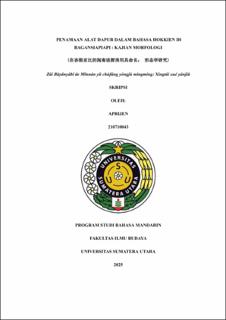Penamaan Alat Dapur dalam Bahasa Hokkien di Bagansiapiapi : Kajian Morfologi 在峇眼亚比的闽南语厨房用具命名: 形态学研究 (Zài Bāyǎnyàbǐ de Mǐnnán yǔ chúfáng yòngjù mìngmíng: Xíngtài xué yánjiū)
Naming Kitchen Tools in Hokkien Language in Bagansiapiapi: A Morphological Study

Date
2025Author
Aprijen, Aprijen
Advisor(s)
Adha, T Kasa Rullah
Yusuf, Muhammad
Metadata
Show full item recordAbstract
This research entitled Naming Kitchen Tools in Hokkien Language in Bagansiapiapi: A Morphological Study, compiled by Aprijen (210710043) aims to identify and document the naming of kitchen tools in the Hokkien language in Bagansiapiapi. This research uses Leonard Bloomfield's structural morphology approach. The research method used is descriptive qualitative which aims to describe and analyze the form, structure and meaning of the names of kitchen tools in the Hokkien language in depth without using quantitative data. Data collection techniques through three ways, namely: (1) in-depth interviews with native speakers of Hokkien in Bagansiapiapi; (2) participatory observation to observe the use of terms in everyday life; (3) documentation, recording terms, recording interviews and searching for written sources related to the Hokkien language. The data collected is primary data collected directly by the researcher. The data analysis technique uses the content analysis method, which includes: data reduction, data categorization based on morphological types, data analysis and interpretation to find word formation patterns, and conclusion drawing validated through data triangulation between informants. The results of this study found that the naming of kitchen utensils in Bagansiapiapi Hokkien has a compound morphological pattern (bound morphemes), while a small part is in the form of single morphemes (free morphemes). For example, tia (wok), e (pot) as free morphemes, while langseng (dandang), te pue (glass), as compound words. This study documents around 60 kitchen utensil names and describes their morphological patterns, as well as making an important contribution to efforts to preserve Bagansiapiapi Hokkien language and culture amid the threat of modernization and language shift.
Collections
- Undergraduate Theses [323]
